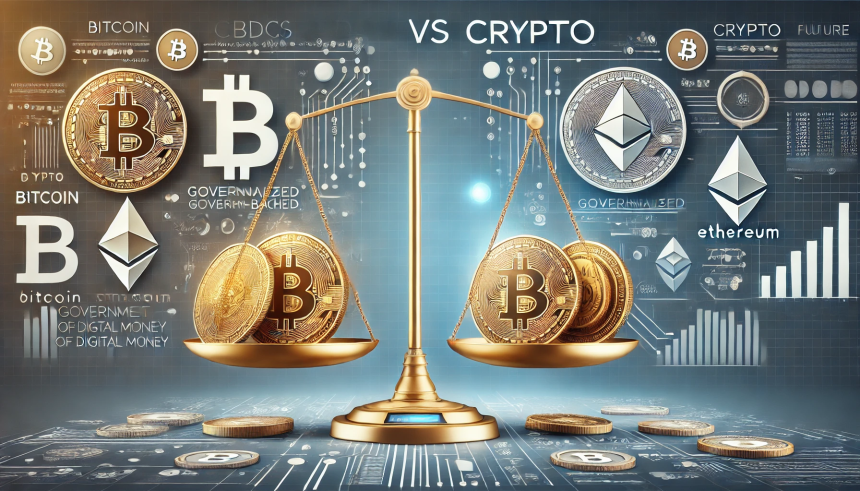Introduction
As cryptocurrencies continue to grow, governments worldwide are launching their own Central Bank Digital Currencies (CBDCs).
CBDCs are digital forms of national currencies, fully regulated and controlled by governments.
This rise of CBDCs now directly competes with decentralized cryptocurrencies like Bitcoin and Ethereum.
What Are CBDCs?
CBDCs are government-backed digital currencies issued by central banks.
Unlike Bitcoin, CBDCs are centralized and pegged to the value of the country’s fiat currency.
Examples include China’s digital yuan, EU’s digital euro, and India’s e-rupee.
How CBDCs Differ from Bitcoin and Ethereum
CBDCs are centralized and controlled, while Bitcoin and Ethereum operate on decentralized, public blockchains.
With CBDCs, governments can track and control transactions, whereas decentralized coins focus on privacy and freedom.
CBDCs aim for price stability, while Bitcoin’s limited supply makes it scarce and volatile.
Why Are Governments Pushing CBDCs?
Governments want to modernize payment systems and reduce reliance on cash.
CBDCs allow faster, cheaper domestic and international payments.
They also give governments greater control over monetary policy and prevent illicit activities by tracking transactions.
Advantages of CBDCs
Faster Payments: Instant transactions without traditional banks.
Reduced Costs: Lower fees for merchants and consumers.
Financial Inclusion: Reach unbanked populations with digital wallets.
Monetary Control: Governments can manage money supply more efficiently.
Risks and Concerns of CBDCs
Privacy Loss: Governments can monitor every transaction, raising surveillance concerns.
Censorship: Authorities can freeze accounts or block transactions.
Competition with Banks: CBDCs may weaken traditional banks, affecting the economy.
Technical Risks: Cyberattacks could target centralized digital currencies.
The Case for Decentralized Cryptocurrencies
Bitcoin and Ethereum offer financial freedom without government control.
They allow people to protect wealth from inflation and corrupt regimes.
Decentralized coins empower users to transact globally without censorship.
Why People Prefer Bitcoin Over CBDCs
Bitcoin’s limited supply (21 million max) makes it resistant to inflation, unlike CBDCs that governments can print endlessly.
Bitcoin is permissionless — anyone can use it without approval.
It offers a hedge against unstable fiat currencies in inflation-hit countries like Venezuela and Argentina.
CBDCs and Stablecoins: Are They Competing?
CBDCs may replace or compete with private stablecoins like USDT and USDC.
While CBDCs are state-controlled, stablecoins are issued by companies but pegged to fiat currencies.
Some experts believe CBDCs will limit the growth of stablecoins by offering a “safer” alternative.
Countries Leading the CBDC Race
China: Fully launched digital yuan in major cities.
India: Testing digital rupee for public use.
EU: Digital euro under development, focused on privacy and security.
USA: Still researching a digital dollar but lagging behind other nations.
Impact on Global Trade and Banking
CBDCs could replace SWIFT for faster international settlements.
Banks may lose deposits, as people could hold CBDCs directly in central bank accounts.
CBDCs may simplify tax collection and reduce financial crime, but also increase government control.
What Experts Are Saying
Crypto advocates: Warn against CBDCs for their surveillance risk and control over users.
Economists: Support CBDCs for their efficiency and financial inclusion.
Tech experts: Call for balance between privacy and regulation in CBDC design.
Can CBDCs and Cryptocurrencies Coexist?
Some believe CBDCs and decentralized crypto can serve different roles.
CBDCs for daily transactions and wages, while Bitcoin for long-term savings and inflation hedge.
Integration could happen, where CBDCs are used for small payments, and Bitcoin for large international deals.
The Role of Privacy Coins in a CBDC World
Privacy coins like Monero and Zcash may become more popular as people seek escape from CBDC surveillance.
Governments may try to ban or regulate privacy coins as CBDCs rise.
The debate between privacy and control will intensify as CBDCs expand.
The Future of Digital Money
Digital money is inevitable, but who controls it is the key question.
If CBDCs dominate, governments will gain unprecedented control over financial systems.
If decentralized coins thrive, people retain financial freedom and privacy.
The balance between the two will define the future of money.
Conclusion
CBDCs and decentralized cryptocurrencies represent two opposing visions of the future.
CBDCs focus on control, stability, and efficiency, while Bitcoin and Ethereum focus on freedom and decentralization.
As CBDCs roll out globally, the fight for financial privacy and independence will continue.
The future will depend on how governments, businesses, and citizens respond to these changes.









